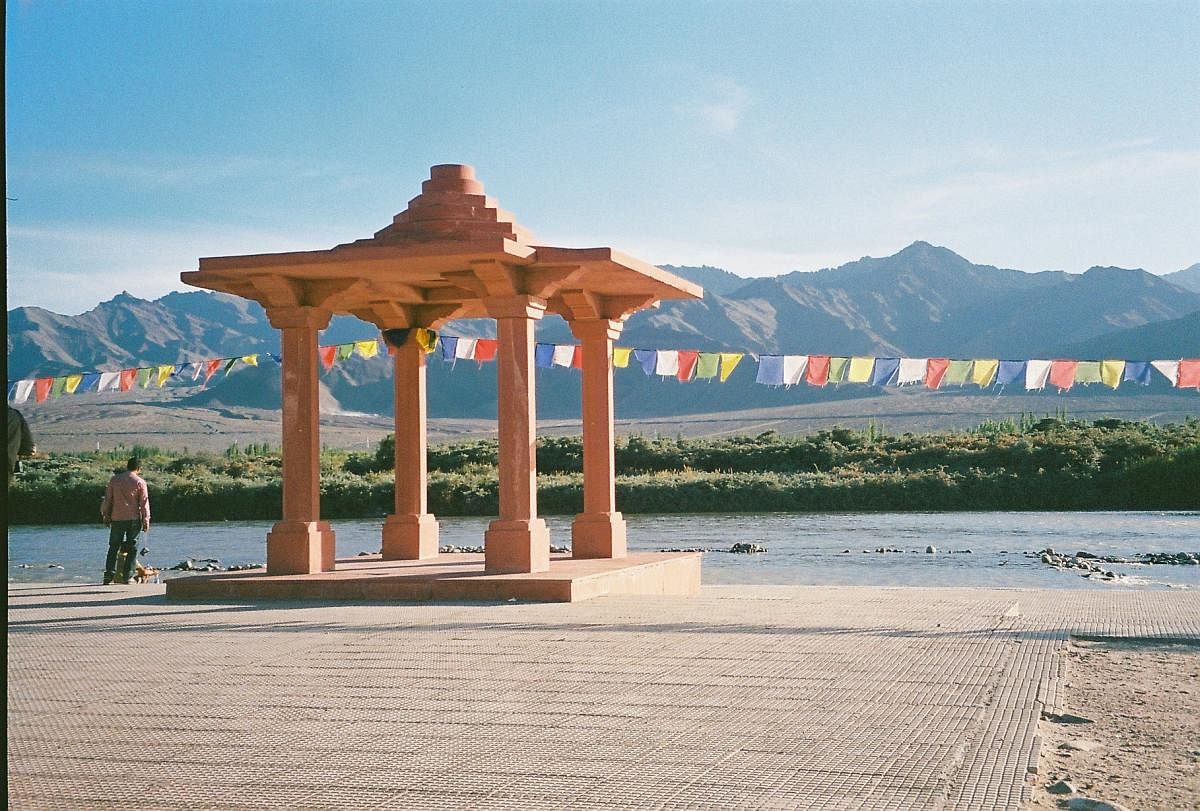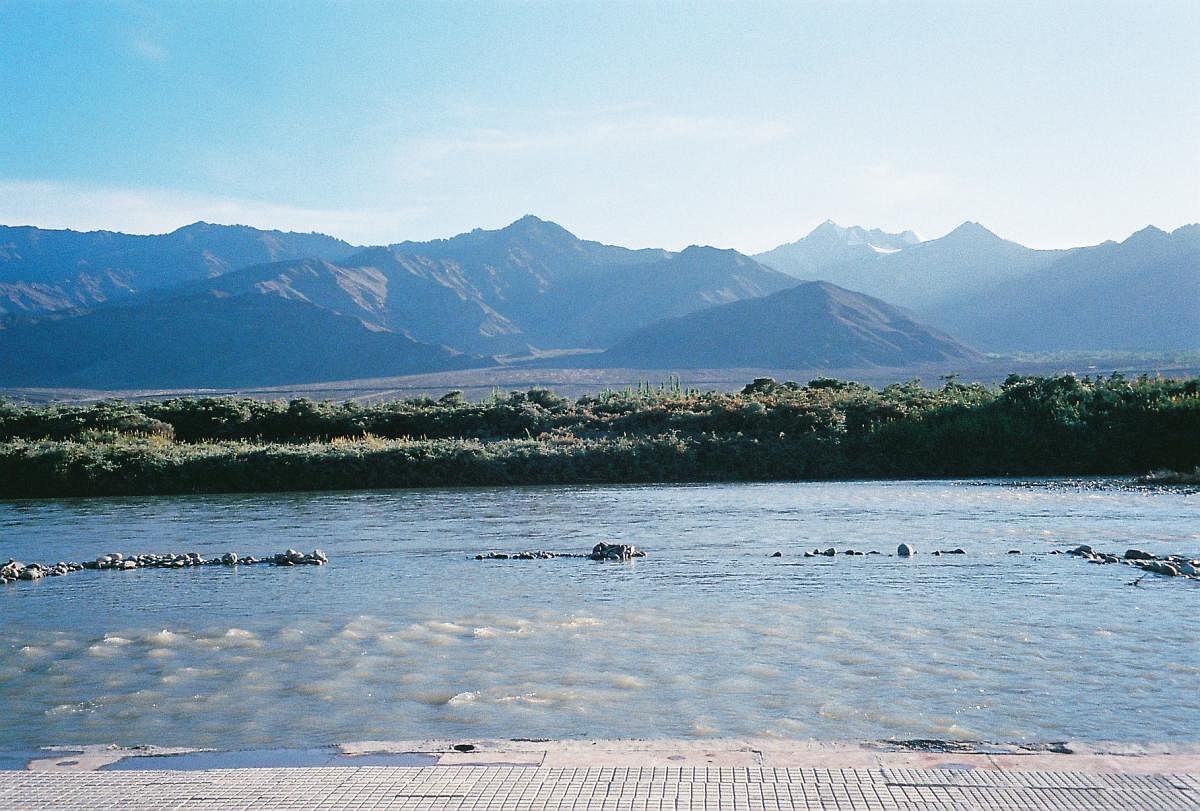

Even as the proxy war rages on between India and China, a river steeped in history, legend and myths quietly flows through Ladakh before finally merging into the Arabian Sea near Karachi. Does the name Senge Tsampo ring a bell in your mind? This is River Sindhu or Indus. Senge Tsampo, as it is known among Tibetans and Ladakhis, means the Lion River.
A Greek navigational manual called the Indus ‘the greatest of all the rivers that flow into the Erythraean Sea.’ In ancient geography, the term Erythraean comprised the Arabia Sea, the Red Sea and the Persian Gulf. Pliny the Elder, a naval and army commander of the early Roman Empire described Indus as the Western boundary of India.
Indus River is outside the tourist radar although a stretch of it is easily accessible from the city centre of Leh, a journey of 10 km. When our motley group visited the spot where people converge once a year, we found it deserted except for a lone Sindhi family. To appreciate Indus, you need solitude.
Meditating on the banks of the Indus I recall the Assamese song of Bhupen Hazarika on the Brahmaputra, a river which also originates from Mount Kailash (O mighty Brahmaputra / Maha-bahu Brahmaputra / The abode of many a confluence/ For millennia, it has illumined to mankind/ The true import of assimilation). The same sentiment applies to the Indus.
The Indus flows around a breathtaking landscape with snow-capped peaks, glaciers and rugged mountain people. As we approach closer, the rays of the bright sun shimmer in the glassy surface of the river. The water is crystal clear. We dipped our feet in the cool waters experiencing an exhilarating feeling. It was nature’s spa. As it was not yet winter, the water was not icy cold.
That a stretch of the river passed through Ladakh was little known to the people outside of Ladakh and seldom visited. Part of the reason is that Ladakh was cut off from India for six to eight months of the year. It was opened comparatively recently to the army in 1962 and to tourism in 1974. It suddenly came into the limelight when the then Home Minister L K Advani visited Ladakh in 1996. He wanted to know the river which flowed in this region. The hosts told him that it was Senge Tsampo and as an afterthought added its Sanskrit name, “Sindhu.” A surprised Advani, a Sindhi, came back to Delhi and founded the “Sindhu Darshan”, an annual Hindu pilgrimage on the banks of Indus near Shey Manla town in Ladakh. The first edition of the three-day festival was held in 1997 and thereafter it is held every year.
It was a kind of rediscovery of a river that has lent its name to a province (Sindh), to a country (India/ Hindustan), a community (Sindhi) and a ubiquitous religion (Hindus). People outside Ladakh assumed Indus to be a Pakistani river. Pakistani cricketer-turned-politician Imran Khan wrote a book, “The Indus journey: A personal view” (1990) in which he calls Indus the ‘lifeline of Pakistan.’ It may be the lifeline of Pakistan, but for India, it is its identity. It was only in the early 2000s that Alice Albinia travelled through the entire course of the Indus River from Karachi to its source in Tibet to write her seminal book, Empires of the Indus: The story of a river.
A rusty, dilapidated metal board proclaims in Hindi and English that the foundation stone for the Sindhu Ghat was laid by Atal Bihari Vajpayee, Prime Minister of India on 7 June 2000. The ghat is built across the river. It is similar to the ghats you find in Varanasi, though not used for the same purpose. There is a permanent concrete pandal for pooja during the Sindhu Darshan. The ghats appear to be incongruous with the pristine surroundings. But Indus is long enough in Ladakh to enjoy its varying moods as it meanders its way in different locations.
The perennial source of Indus rises from the ground at the base of Mount Kailash (Kangri Rinpoche) in Tibet. The source of the river is called, “Senge Khabab” (Lion’s Mouth).
The main river is joined by other tributaries. The Indus enters Ladakh at Demchok at a height of 4,500 feet. In Ladakh, the principal left bank tributary of the Indus is River Zanskar. The Zanskar, which is fed by the snows and glaciers of the Himalayas, has a greater volume of water than the Indus itself before that point. The Zanskar, which has a length of about 370 km, joins the Indus near the village Nimmu and the point is known as Sangam. In Ladakh, the Indus runs for a total of about 450 km of Indian soil before it enters Pakistan at Batalik.
Indus is a river of many moods. It gushes, glides and glistens through the breadth of Ladakh. It forms sand dunes and freezes in winter. It supports terrace farming. A verse in the Rig Veda says, “So swift is Sindhu, nothing can impede.” For us, the soft gurgling sound which was music to our ears lingered long after we left its banks.